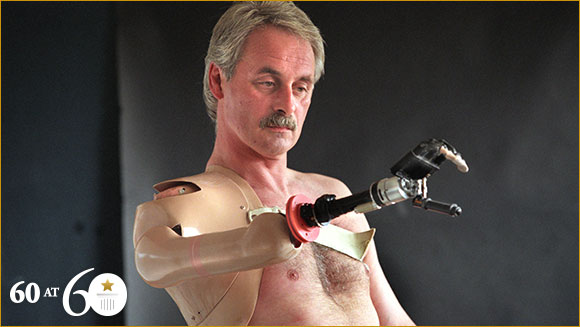
Life took a downturn for Robert Campbell Aird (UK) in 1982, when he was diagnosed with muscular cancer. To prevent the disease from spreading, doctors were forced to amputate his arm. But 11 years later, Robert was centre stage in a landmark development for surgery and bio-engineering – one that has improved the quality of life for many of his fellow amputees.
For in a pioneering operation in 1993, Robert was given the world’s first bionic arm – less pithily, the “Edinburgh Modular Arm System”. The prosthetic was created by a team of five bio-engineers at the Margaret Rose Hospital in Edinburgh, UK, while the surgical team was led by Dr David Gow. Robert’s new limb incorporated microchips, circuitry to enable him to engage it in different positions, and a host of tiny gears, pulleys and motors, all sheathed in highly realistic artificial skin. Just like his other arm, Robert’s new limb could rotate fully at the shoulder, turn at the wrist and bend at the elbow, while the fingers enabled him to grip.
Robert operated his new arm by means of a cap, which he wore all the time; this contained mico-sensors, which detected the electrical brain impulses that were being sent to the missing limb and deployed them to the bionic arm. It marked a giant step forward in prosthetics, and Robert’s life was transformed: “For the first time in 16 years, I recently reached above my head to pick a book off a shelf,” he marvelled, not long after his operation. “It was a great moment for me.”
His brush with fate galvanised this redoubtable man, who once described himself as “part man, part machine, all Scottish”. In the years following his surgery, Robert spent much of his spare time fund-raising for charities and support Dr Gow’s research. A peerless role model for wearers of prosthetic limbs, he wind-surfed across the Forth river and the English Channel (the latter in 2 hr 2 min) – quite literally “single-handedly”. He set about making full use of his bionic arm, taking flying lessons in 1999 and winning a total of 14 trophies for clay pigeon shooting. And all this alongside his day job as a highly successful hotelier.
So the story of Robert Campbell Aird is really two stories: one about pioneering surgery and technological breakthroughs; and the other about a man’s insatiable appetite for life. And you won’t be surprised to hear that, alongside his other admirable characteristics, Robert had a great sense of humour. Once, in Edinburgh, he found himself sitting next to a young girl. She wouldn’t stop biting her nails. Noticing Robert’s artificial limb, she asked him how he lost the arm he was born with. “I bit my nails,” he replied.
Of course, technology never stands still. Today, scientists are developing ever more refined prosthetics, that strive to mimic the subtle complexities of limb movement or the manipulation of fingers. Driven in part by the limb loss suffered by members of the military, since 2006 the US Pentagon’s Defense Advanced Research Projects Agency (DARPA), has been funding research into state-of-the-art prosthetics.
The MPL is still in research, and is likely to be for some time. But right now, genuine bionic arms – which pick up on electrical signals from the wearer’s brain, just like Robert Cambpell Aird’s cap – are being created by means of 3D printing. And crucially, they can be manufactured for the fraction of the cost of most commercially available prosthetics. Step forward Alex Pring, a young boy with just such an arm. Created by a team of student engineers at the University of Central Florida, led by Albert Moreno, Alex’s bionic arm cost just $350 to create. And it’s won him quite a few new friends, too – including Iron Man…
